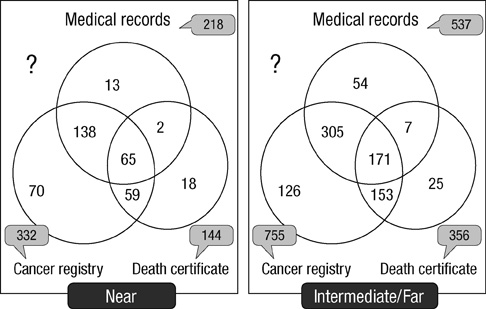J Korean Med Sci.
2012 May;27(5):489-494. 10.3346/jkms.2012.27.5.489.
Completeness of Cancer Case Ascertainment in Korea Radiation Effect and Epidemiology Cohort Study
- Affiliations
-
- 1Department of Preventive Medicine, Seoul National University College of Medicine, Seoul, Korea. yoahn@plaza.snu.ac.kr
- 2Institute of Radiation Effect & Epidemiology, Seoul National University Medical Research Centre, Seoul, Korea.
- KMID: 1372789
- DOI: http://doi.org/10.3346/jkms.2012.27.5.489
Abstract
- The aim of this study was to evaluate whether the completeness of case ascertainment during the follow-up of a cohort differed between the exposed and the nonexposed groups in Korea Radiation Effect and Epidemiology Cohort (KREEC). The completeness was defined as the proportion of the number of detected cases to the number of estimated cases, in which the estimation was performed by capture-recapture method. Data were obtained from the cancer registries, death certificates, and medical records during years 2004-2007. Among 11,367 subjects in the exposed group and 24,809 subjects in the unexposed group, the completeness of cancer case ascertainment were 88.2% vs 87.2% in cancer registry, 38.2% vs 41.1% in death certificate and 57.9% vs 62.0% in medical records data, 96.9% vs 97.1% for all combined sources and were not statistically different between the two groups. In conclusion, the method of ascertaining the cases in the KREEC was not biased depending on the exposure status, and thus adds credibility to the outcomes of the KREEC study as well as confirming the incident cases in the two groups.
Keyword
MeSH Terms
Figure
Reference
-
1. Gordis L. More on causal inferences: bias, confounding, and interaction. Epidemiology. 2009. 4th ed. Saunders, Elsevier;247–263.2. Ahn YO, Yoo KY, Park BJ, Kim DH, Bae JM, Kang D, Shin MH, Lee MS. Ahn YO, editor. Errors and bias in research results. Epidemiology: the principles and applications. 2005. Seoul: Seoul National University Press;307–331.3. International Working Group for Disease Monitoring and Forecasting. Capture-recapture and multiple-record systems estimation I: history and theoretical development. Am J Epidemiol. 1995. 142:1047–1058.4. Regal RR, Hook EB. Goodness-of-fit based confidence intervals for estimates of the size of a closed population. Stat Med. 1984. 3:287–291.5. Schmidtmann I, Blettner M. How do cancer registries in Europe estimate completeness of registration? Methods Inf Med. 2009. 48:267–271.6. Tilling K. Capture-recapture methods: useful or misleading? Int J Epidemiol. 2001. 30:12–14.7. International Working Group for Disease Monitoring and Forecasting. Capture-recapture and multiple-record systems estimation II: applications in human diseases. Am J Epidemiol. 1995. 142:1059–1068.8. Hook EB, Regal RR. Capture-recapture methods in epidemiology: methods and limitations. Epidemiol Rev. 1995. 17:243–264.9. Neugebauer R, Wittes J. Voluntary and involuntary capture-recapture samples: problems in the estimation of hidden and elusive populations. Am J Public Health. 1994. 84:1068–1069.10. Brenner H, Stegmaier C, Ziegler H. Estimating completeness of cancer registration: an empirical evaluation of the two source capture-recapture approach in Germany. J Epidemiol Community Health. 1995. 49:426–430.11. Kim DS, Lee MS, Kim DH, Bae JM, Shin MH, Lee CM, Koo HW, Kang W, Ahn YO. Evaluation of the completeness of cancer case ascertainment in the Seoul male cohort study: application of the capture-recapture method. J Epidemiol. 1999. 9:146–154.12. Lee MS, Kang WC, Kim DH, Bae JM, Shin MH, Lee YJ, Ahn YO. Methodologic considerations on the cohort study of risk factors of stomach cancer: on the incompleteness of case ascertainment. Korean J Epidemiol. 1997. 19:152–160.13. Im JS, Kweon SS, Park KS, Sohn SJ, Choi JS. Completeness estimation of the population-based cancer registration with capture-recapture methods. Korean J Prev Med. 2000. 33:31–35.14. Kim MH, Park JK, Ki MR, Hur YJ, Choi BY, Kim JS. Evaluation of the completeness of case reporting during the 1998 Cheju-do mumps epidemic, using capture-recapture methods. Korean J Prev Med. 2000. 33:313–322.15. Ha M, Kwon HJ, Kang DH, Cho SH, Yoo KY, Joo YS, Sung JH, Kang JW, Kim DS, Lee SI. Completeness estimation of the Korean medical insurance data in childhood asthma. Korean J Prev Med. 1997. 30:428–436.16. Bae JM, Ahn YO. A nested case-control study on the high-normal blood pressure as a risk factor of hypertension in Korean middle-aged men. J Korean Med Sci. 2002. 17:328–336.17. Bae J, Gwack J, Park SK, Shin HR, Chang SH, Yoo KY. Cigarette smoking, alcohol consumption, tuberculosis and risk of lung cancer: the Korean multi-center cancer cohort study. J Prev Med Public Health. 2007. 40:321–328.18. Won YJ, Sung J, Jung KW, Kong HJ, Park S, Shin HR, Park EC, Ahn YO, Hwang IK, Lee DH, et al. Nationwide cancer incidence in Korea, 2003-2005. Cancer Res Treat. 2009. 41:122–131.
- Full Text Links
- Actions
-
Cited
- CITED
-
- Close
- Share
- Similar articles
-
- Cancer Risk in Adult Residents near Nuclear Power Plants in Korea: A Cohort Study of 1992-2010
- Cohort Study
- Power Estimation and Follow-Up Period Evaluation in Korea Radiation Effect and Epidemiology Cohort Study
- Occupational Lymphohematopoietic Cancer in Korea
- Completeness Estimation of the Population-based Cancer Registration with Capture-Recapture Methods



